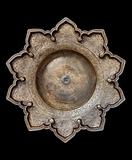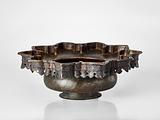Bowl of cast and engraved bronze
India, Deccan; 15th century
H: 8.2; Diam: 22.7 cm
With its jagged edge, this bowl resembles a star or a stylised, ten-petalled flower. It may have been used to catch the water which servants poured over visitors’ hands before a meal. Many later examples of such hand basins from India exist, and they often have the same wide rim and compact, round body as this bowl (
73/1980).
The bowl originates from the Deccan in Central and South India, and in several respects its shape is inspired by the local, Islamic architecture. Many Deccan princely palaces have large, star-shaped water features, and the bowl here may have been conceived as a miniature version of such pools.
[1]The downward jagged border along the rim of the bowl is another ornament familiar from Deccan architecture; it is also used on other architecturally inspired metalwork from the area (
2/2016).
By contrast, the engraved design of twisted arabesques adorning the inner and outer rim of the bowl is inspired by art from Iran and Central Asia; the ornamentation is reminiscent of that of a contemporary Timurid piece of woodcarving (
15/2014).
The Bahmanid dynasty, which ruled the Deccan in the fourteenth and fifteenth centuries, was highly influenced by Iranian and Timurid art and culture and had objects ranging from small utensils to entire building complexes decorated in the Iranian/Central Asian style of the time.
[2]
Inv. no. 24/2019
Published in:
Christie's, London, 25/11-1985, lot 382;
Mark Zebrowski: Gold, silver and bronze from Mughal India, London 1997, pp. 174-177, pls. 254a-c;
Navina Najat Haidar and Marika Sardar: Sultans of Deccan India, 1500-1700: opulence and fantasy, Metropolitan Museum of Art, New York, New Haven 2015, cat.no. 5, p. 40;


